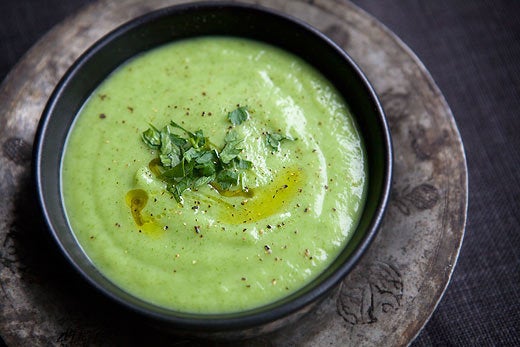
We're sure you hear it all the time from your most food-obsessed friends: once you make your own soup stock, you'll never go back to the store-bought stuff. From someone who's been making their own stock for some time now, let me say, yes and no.
Once you figure out how to make stock at home that tastes better than anything you can buy in the grocery store for a quarter of the price, you will be very excited. But guess what? There are not a ton of absolutes in life, and sometimes I still buy the stuff in a box (I've sworn off the can, however)! Here's what's important: you can save a ton of money, accidentally over-salted soup and "oops I forgot to get stock at the grocery store" moments by making your own and keeping it in the freezer. Wasting money, accidentally over-salting soup and forgetting to buy everything we need at the grocery store are all things that really stress us out, and this year, we've vowed to cut them out.
You may be hesitating to make your own stock because it sounds complicated. I'll be honest with you, there are some complicated stock recipes out there. I don't follow them, and although my stock is rarely crystal clear and perfectly clarified, it always tastes really, really good.
You may be hesitating to make your own stock because it sounds expensive. I suppose that if every time you wanted to make a batch of stock you went out to purchase the freshest chicken, the tenderest young vegetables and brand new herbs to simmer, it would be pretty expensive. Don't do that.
Do this: as you cook, save those odd carrot heels, the greens not quite fit for a salad, the stems of mushrooms, ribs of kale and collard greens, hunks of onion and Parmesan rinds. Put all of these things, gradually, as you produce them, into a gallon-sized plastic bag and keep it in the freezer. When it's full, you make vegetable stock. If you also happen to have the carcass of a roast chicken left over, you make chicken stock. If you like thyme a lot, throw a bunch in. The best thing about homemade stock is that you control the flavor and seasoning. If you've ever eaten broccoli soup made with stock from broccoli stalks, you'll understand that soups can change your life this way.
Here's what to do:
- Once that bag of vegetable bits in the freezer is full and you have a few hours to kill, empty the contents of the bag into the biggest soup pot you have (I use one with a strainer you can set inside, to make straining easier later). Then, just fill the pot with cold water, just until it covers all your vegetables. I like to pour the water in quart by quart to keep track -- you'll usually end up with a little more than half the liquid you start with. (If you're making chicken stock, start this whole process with just the bones and salt for an hour or two, then add the vegetables and proceed as normal.)
- Add salt. Seriously, add salt. Add salt like you would when you salt pasta water. There's a lot of water in there and you want to make sure water isn't all it tastes like. But, don't forget that you'll be able to adjust the seasoning when the stock is done, so don't dump in a whole cup. Three or four big pinches is usually a good place to start.
- Add herbs and spices. I usually use some combination of bay leaves, black peppercorns, a little coriander, maybe a clove or two. You know what spices you like, so experiment. As far as herbs go, you really can't go wrong with parsley and thyme, but definitely experiment with others. If you want to get fancy and tie this into a bouquet garni, go nuts, but you are going to strain this later, so don't freak out.
- Turn the heat on. It feels kind of unnatural to start all these ingredients in cold water, right? You wouldn't want to if it were a soup, but slowly bringing ingredients to a boil with water and salt draws all their liquids out of them, which is just what you want to do with stock. By the time these veggies are done simmering, they should be nearly flavorless, because all their flavor will have been sucked out into the broth. Bring your stock to a rolling boil, then knock the heat way down so it just simmers -- meaning just a few bubbles rise to the top.
- Then leave it for at least forty five minutes. Skim off any crud that rises to the top. (I use a big spoon for crud and a rolled up paper towel for fat. If you're using meat bones, you'll have to skim more frequently than you would with just vegetables.) Give it a stir. Does it taste like anything yet? If not, let it simmer until it does.
- Once you're happy with how your stock tastes, turn off the heat and cool this sucker down quick (this is important so you don't grow bacteria in it and make yourself sick). Fill your clean sink with ice cubes and cold water, then just set your pot in there and stir the stock around until it cools down. Once you're close to room temperature, set a fine strainer over whatever you'll be using to store your stock (I like to use both pint and quart-sized plastic takeout containers, so I only have to defrost as much as I'll use) and ladle your stock in.
- Store in the freezer until you need them. Boom. You're done. You'll never forget it at the grocery store again.
Any questions or tricks of your own? Share the wealth in the comments!
